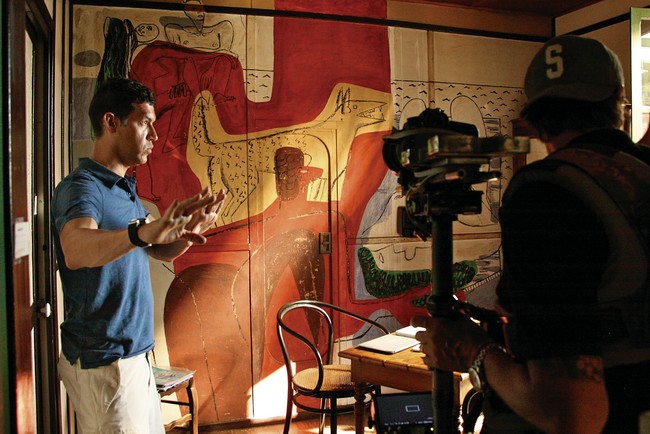
On October 15, a film will debut at the Architecture and Design Film Festival in New York (Architectural Record is a media sponsor) as well as open a new chapter for a largely forgotten designer. The documentary, Gray Matters, was produced, written, and directed by Marco Orsini and explores the life and works of Eileen Gray (1878-1976).
 |
| Photo © Mathew Thompson Eileen Gray's Non-Conformist Chair. |
Gray is known to many in the art and architecture world for her early lacquer handiwork and extensive furniture designs, the originals of which fetch millions in auctions. Her Bibendum chair and E-1027 table are instantly recognizable classics. However, she would certainly not want to be remembered as a designer for the rich and privileged. A contemporary of Le Corbusier and many early modernists, she shared their zeal for bringing new and intelligent modern designs to all of society. However, like many woman architects in the 20th century, her fame never grew to match her importance within the design world. Orsini’s documentary seeks to reverse her exclusion from public view and bring her beliefs—namely that everyone should be conscious of how they design their life—back into focus.
Marco Orsini began producing television in 1999 and has since written, produced, and directed two documentaries, not including Gray Matters. He is founder and director of Mojo Entertainment LLC since 1998 and President of the International Emerging Film Talent Association (IEFTA) since 2005. He has travelled extensively to Ethiopia where the IEFTA has worked to promote young Ethiopian filmmakers and where Orsini filmed a 2009 documentary, The Reluctant Traveler.
Your previous documentaries and productions weren’t related to architecture or design. How did you learn about Eileen Gray’s story?
I have a very good friend by the name of Mary McGuckian, a talented female Irish filmmaker, who had been researching Eileen Gray for seven years in preparation for her own feature-length drama on Gray, titled Price of Desire. She had approached me and said, “I’ve done so much work on this that it would be a shame if someone didn’t actually do a proper documentary as a companion.” I thought it was a great opportunity. She basically handed it all to me on a silver platter: all the research, all the contacts, all the museums.
What qualities of Gray’s designs immediately struck you? There must have been a moment when you were exposed to all her work at once.
What really struck me was how she changed the way we live today. In other words, she had an idea of mass production for the everyday man. Though she’s labelled an Art Deco designer, she realized early on in her career that her lacquer work, the work she was doing for Jacques Doucet and Madame Lévy, was just an expensive product for a limited few. She wanted to change that and that’s where I think she had the most impact.
Your previous films certainly focus on the human element or the human drama, whether it’s bringing global issues to a dinner table in Dinner at No-Gos or documenting your personal journey in Ethiopia in The Reluctant Traveler. However, Gray’s story is also the story of Art Nouveau, Early Modernism, and the art history of the 20th century. How did you balance her personal story with the wider historical movements?
The sad thing about Eileen Gray is that she was overlooked her entire life. One could actually question who used tubular steel in design first: was it Marcel Breuer or Eileen Gray? It depends on who you ask. There was also Le Corbusier and [Jean] Badovici, her lover, taking credit for her work. So, there is a part of history no one knows about: the things she experimented with, as well as what she did for the way we live today. My story focuses on the lack of history on her life and the confrontations she had with other designers. Basically, she was in a man’s world and any good female architect had a man standing behind her, unfortunately.
The most famous figures of the modernist movement are all men. Women were usually marginalized during and after their career. For example, the importance of Anne Tyng in Louis Kahn’s work is usually overlooked. Not only was Gray a woman, she was also bisexual at a time when that was not publically acceptable. Later in life she received few honors, yet remained active in furniture design until her death. What about Gray allowed her to persevere?
I think a little bit of money helps. She had enough money to live. She also had an education. And a title, though one she rarely used. She came from a somewhat prominent family. So here’s a woman in the 1920’s who had education, who had some money, who was able to dabble and do things on her own. She drove a car, she had taken transcontinental flights, so she could have amazing journeys.
Who’s the audience for the documentary? Architects, artists, anyone off the street?
Artists and architects of course, but it can be anyone. I played it for my in-laws just recently and they said, “We don’t know her, we don’t know if we would care about her, but the film was informative and now we’re looking around and realizing how much she actually influenced us.”
The E-1027 House, a modernist concrete residence designed and built from 1926-29, is her perhaps her greatest masterpiece. However, there’s been a lot of controversy about its recent restoration, namely that certain design decisions were not faithful to the original design. Furthermore, Le Corbusier painted several murals in the house when he lived there. Gray considered it vandalism yet they remain there. Do you have any comments on those two situations?
Without diving into the current political situation, I will say that there were mistakes made in the restoration. There were a few exceptions, to be sure: for example, Gray used a form of concrete that’s not in existence today and would be very difficult to reproduce. That aside, to the people who say that the Le Corbusier murals should be taken down, my comment would be that if it weren’t for those murals, that house would not exist. It would have been torn down a long time ago. However, Le Corbusier was well-known. The house sits on Le Corbusier Avenue. So, that house, Eileen Gray, Le Corbusier, are intertwined. Gray and Corbusier themselves had a very interesting relationship and even though they didn’t get along they respected each other very much. My film focuses a lot on that relationship as well as the yin and the yang between the two. So for me, the murals have to stay. However, it’s nice to shoot the house without the murals there, which is what I was able to do.
What do you see for Gray’s legacy and what’s next for you?
There’s a lot currently going on with Eileen Gray. For example, Julian Lennon has limited edition photographs coming from the set designs of the narrative feature Price of Desire. It is a beautiful, epic film, and though its release date is still being determined, it’s going to be quite a thing when it comes out. Of course, there’s also the opening of E-1027 House this spring, so I’m hoping to participate in all these Eileen Gray events.

Post a comment to this article
Report Abusive Comment